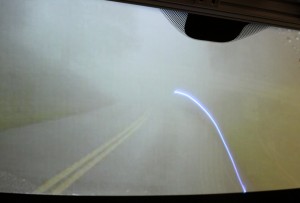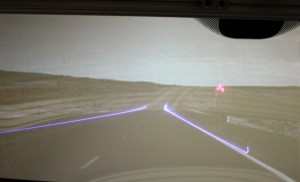General Motors R&D and several universities are working on a system that would use data gathered from vehicle sensors and cameras, and then project images across the entire surface of the windshield.
This next generation head up display uses a combination of night vision, navigation and camera technologies. A variant, sometimes called synthetic vision, is already widely in production in the aviation industry.
Enhanced vision might make more sense in automobiles than traditional head up displays, since it potentially provides greater value to the driver.
GM introduced HUDs back in 1988 to almost universal yawns, as I recall. Head-up displays are currently available on the GMC Acadia, Chevrolet Corvette, Buick LaCrosse and Cadillac STS models, and provide speed, lane-change indicator status and vehicle warning messages directly into the driver’s field of vision. BMW, Citroën, Honda, Infiniti, Saab, Nissan Toyota, and Lexus vehicles, among others, offer some form of HUD. Aftermarket units are also available for several hundred dollars.
Emerging electronic technology could allow enhanced vision images to be generated by ultra violet lasers and be projected onto the entire windshield, creating a virtual road that is closely aligned with reality. The windshield is coated with transparent phosphors, which emit visible light when excited by the laser light beam. Thus, the windshield becomes a “large area transparent display,” instead of current HUD systems that use only a small portion of it.
“We’re looking to create enhanced vision systems,” says Thomas Seder, group lab manager-GM R&D. His team is working with Carnegie Mellon University and The University of Southern California, as well as other institutions, to create a full windshield head-up system leveraging night vision, navigation and camera-based sensor technologies to improve driver visibility and object detection. 
“Let’s say you’re driving in fog, we could use the vehicle’s infrared cameras to identify where the edge of the road is and the lasers could ‘paint’ the edge of the road onto the windshield so the driver knows where the edge of the road is,” Seder says.
The ability to use such a large surface enables the system to alert drivers of potential dangers that exist outside of their normal field of vision—including children playing or motorcycles passing, or animals on the side of the road.
On that foggy day, perhaps worsened by sleet or snow, the enhanced vision system could combine night vision with the head-up system to identify and highlight the location of threats.
“This design is superior to traditional head down display-based night vision systems, which require a user to read information from a traditional display, create a mental model and imagine the threat’s precise location in space,” Seder says.
As an added safety feature, the head-up system can be combined with automated sign reading technology, similar to the Opel Eye system that debuted on the 2009 Opel Insignia, to alert the driver if they are driving over the posted speed limit or if there’s impending construction or other potential problems ahead. The system can use navigation system data to alert the driver of their desired exit by reading overhead traffic signs.
“We have done testing on a number of drivers and their performance is better relative to head-down systems that are commonly used in vehicles today,” Seder said. “It’s a compelling design.”
GM says that full windshield head-up system has not yet been slated for a future GM vehicle program. Seder says, however, some of the supporting technologies could end up in GM vehicles in the near-term future.



